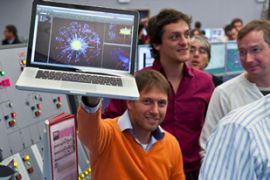Scientists restart Big Bang machine
Sub-atomic particle collider aims to resolve questions about creation of the universe.

A spokesman for the organisation said scientists hope to have beams circulating by early Saturday.
“At the moment they’re putting beams down in the Large Hadron Collider and as the night goes on they’ll take the beams through and start circulating them,” James Gillies told the Reuters news agency.
Complex experiment
The machine circulated its first beams on September 10, 2008, but it was shut down days later because of a fault in the cooling system.
It failed again in late September of last year after an electrical malfunction caused a helium leak in the tunnel.
| The Big Bang theory |
|
The phrase “big bang” was coined in 1949 by Fred Hoyle, a British scientist. Hoyle was trying to disparage the then emerging theory, which countered his own “steady state” view – that the universe had always existed and was evolving but was not expanding. The Big Bang theory suggests the universe began as a speck at extremely high temperature and density and rapidly expanded and in doing so cooled. |
“The LHC is a far better understood machine than it was a year ago,” the Associated Press news agency quoted Steve Myers, Cern’s director for accelerators, as saying.
“We’ve learned from our experience and engineered the technology that allows us to move on. That’s how progress is made.”
The LHC took nearly 20 years to complete and is one of the costliest and most complex scientific experiments ever attempted.
More than 2,000 scientists from around the world have worked on the project, which hopes to observe a particle known as a Higgs Boson, that scientists hope will explain how particles pick up mass.
The Higgs was named after Peter Higgs, a British physicist who devised the theory of its existence in 1964.
The collider will send protons in opposite directions along a 27km circuit – the protons will travel the 27km 11,000 times per second – and at four points the protons will intersect and smash together.
Scientists will monitor the collisions and collect data on the particles created by these collisions, which they say will come close to re-enacting the Big Bang – the theory that a colossal explosion created the universe.
The project could also help prove the theory of super symmetry, a theory in particle physics that suggests every particle has a corresponding partner particle.
